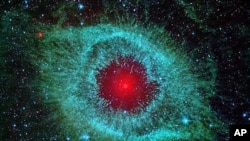Two international teams of astronomers say the rapid discovery and classification of the youngest type-1a supernova ever detected has led to the unraveling of several decades-old mysteries about these colossal, intensely bright stellar explosions that scientists use to measure the universe.
The astronomers say surprising new findings made in the analysis of the potent type-1a thermonuclear blast validated some long-suspected ideas about the kind of stars that detonate as supernovas, and let them rule out other related theories.
The scientists say the research revealed the first evidence showing that a category of small, very dense dying stars called carbon-oxygen white dwarfs are responsible for type-1a supernovas. These white dwarfs lie within binary star systems, which have two stars that orbit each other. When the white dwarf siphons off too much material from its neighbor, the white dwarf self-destructs as a type-1a supernova.
The astronomers say the combination of elements produced in the type-1a supernova let them exclude a variety of long-believed theories about types of potential companion stars that provide the catalyst material the white dwarf consumes before exploding. Topping the new list of prime suspects is a normal star - similar to our own Sun - that is in the main stage of its evolution. However, the researchers say they cannot completely rule out the possibility that the companion star could be another white dwarf.
The young type-1a supernova the scientists analyzed was discovered in late August. It is located in the Pinwheel Galaxy some 21 million light-years from Earth, which by cosmic terms, is relatively nearby. The astronomers say such close proximity helped them make such a sensitive detection only 11 hours after the supernova occurred, and to pinpoint the time of the actual blast to within an astounding 20 minutes. The scientists say it is the first time a stellar thermonuclear explosion has ever been observed so soon after it happened.
Scientists from the University of California, Berkeley and the California Institute of Technology are among the two teams that conducted the research. Two related reports on the groundbreaking findings are published in the journal, Nature. A third report will appear in the publication, The Astrophysical Journal.
All type-1a supernovas produce the same amount of light. That means scientists can calculate the distance of a type-1a supernova by how bright it appears. The dimmer the light from the blast appears, the farther away it occurred.
Using the brightness of type-1a supernovas as a fixed unit to measure the size and expansion rate of the universe is the basis of the pioneering theories by three astrophysicists who were awarded the highly-prestigious 2011 Nobel Prize for Physics earlier this week.
Only certain types of stars turn into white dwarfs at the end of their evolutionary lives. Our own Sun will become a white dwarf after it runs out of nuclear fuel in around five billion years, but it is not expected to meet its end as a supernova.
A light-year is the distance that light travels inside a vacuum in one year - about 10 trillion kilometers.
Astrophysicists: White Dwarf at Center of 1-A Supernova Mystery








